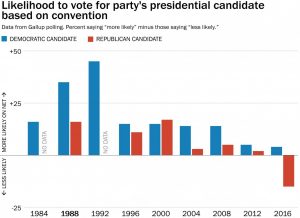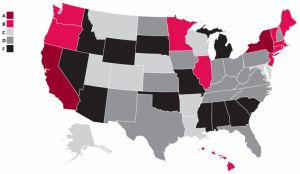The following article by Democratic strategist Mike Lux, author of , is cross-posted from HuffPo:
The problem for a campaign and political party where you seem to be way ahead is the tendency to get cocky and begin to coast. There is great danger in such a moment, especially for a party in need for a historically big victory, as Democrats are right now. Now is the time to work with even greater urgency and aggressiveness to win this campaign, and hopefully win it by a big enough margin that we crush Trumpism and throw it into the dustbin of history. But right now we are at a particularly dangerous moment. Democrats should take nothing for granted and work our hearts out to make damn sure this moment and this potentially historic victory does not slip away from us.
Before talking more about 2016, let me go back in time and remind everyone of some presidential elections in past years. In 1976, Jimmy Carter came out of the two conventions with a huge lead, more than 20 points in many polls. Jerry Ford was burdened with the residue of Watergate, his pardon of Nixon, and an especially nasty recession over the previous couple of years. Had Carter won that race by a big margin, building on the Republican wipeout in 1974, Democrats would have had enough votes and momentum to easily pass sweeping legislation on health care and labor law, and change the political dynamics in the country for a long time to come. Instead the Carter campaign played it safe and coasted, and the lead kept shrinking. In the end, Carter won by only two percentage points. Had a very close Ohio result gone the other way, he would have lost the race entirely. There were no coat tails, no political momentum, and Carter’s early mistakes led to a very weak presidency. In 1988, Dukakis led by 18 points after his convention, with voters tired of a lack of pay raises and massive deficits over the last 8 years. Dukakis took a long August vacation, didn’t respond to the infamous Willie Horton attacks, was awful in the debates, and ended up losing by six points. And in 2000, Gore came out of the conventions up by five points, and I remember Democrats in D.C. being surprised when I said it would be a close race coming down to a few votes in a few states. But Gore was weak in the debates, Karl Rove ran a very effective campaign, and we end up with the Supreme Court giving the election to Bush.
Presidential races can change in a heartbeat or alternatively go slip sliding away. An over-confident campaign can lose its edge, become too cautious and be reluctant to aggressively answer attacks, all of which combine to gradually cause the campaign to lose momentum. In the 1992 Clinton campaign (which, full disclosure, I was a part of), there was never any chance of us losing our edge because we had all just lived through the horror of watching an over-confident and slow to respond Dukakis let his big August lead be reversed. And I have a feeling that Hillary Clinton, being the steely competitor that she is, won’t let her team get over-confident. But the entire Democratic party, from elected officials to grassroots activists, are going to need to, in the old Obama campaign’s signature phrase, stay fired up and ready to go. Never forget that in politics, it is the aggressor who usually wins. Especially in an unpredictable, anti-establishment year, where the pundits and the polls have been proven wrong repeatedly, we must make sure we don’t let Trump, the ultimate unpredictable anti-establishment guy, get a second life.
At the same time we need to fight with the same urgency as if we were in a dead heat or even a little behind, Democrats should be working hard to create the biggest, most sweeping wave election possible. This might seem like a contradiction but it isn’t. Both scenarios demand that we keep our edge and stay aggressive; both scenarios require that we leave no stone unturned to get out every vote possible and persuade every swing voter we can. In fact, I would go so far as to argue that the two most likely scenarios in this election are a Democratic wave and a narrow Trump victory — the latter coming if Hillary’s campaign loses their edge and aggressiveness, and if Democrats in general don’t put enough resources and passion into turning out the Democratic base vote.
Here’s the other thing: Democrats should work toward a wave election with a great deal of urgency, because we are in big need of one. Two of the last three elections have been massive Republican wave elections up and down the line, giving them the biggest margin in the House since the 1920s and most of the governorships and state legislative chambers. We desperately need to build a counter-wave to make up at least some of those numbers, especially considering that off-year turnout in 2018 isn’t going to be demographically as favorable as in a presidential year. And think about how much more Hillary and Democrats can get done if we get a big enough wave to retake the House as well as the Senate, which is a lot more possible in a wave election than conventional wisdom would allow. To actually have at least two years where we could try to pass some good legislation and a decent budget rather than constantly dealing with Republican threats to shut down the government would be a pretty phenomenal thing. One more note: if this turns into a close race, Trump is going to stoke up the “we were robbed” theme and we could have ugliness and violence in this country not seen since the Civil War. If we win big, on the other hand, Trump is humiliated, and Trumpism goes into history’s dustbin.
Such a big year up and down the ticket is in fact made possible by this year’s unique Trump dynamic. It is important to understand the recent history of wave elections: Republicans have been able to keep from losing as many seats in a wave election against them as Democrats have because they have maintained party unity and focused on turning out their base vote. In the 1994 election, Republicans won 52 House seats; in 2010, they won 63. In the 2014 blowout, the only reason they didn’t pick up those kinds of numbers in the House was because they had already won so many two cycles before, and hadn’t lost all that many in 2012, but in statewide races and races further down the ballot they dominated us. By contrast, Democrats only picked up 31 seats in 2006 and 20 more in 2008, both very good years up and down the ballot for Dems. The reason that Democrats tend to get blown out in down years is because they have historically shown much more disunity in bad years, running from their president and their party’s historic message and platform. The result is the Democratic base turnout tends to be abysmal in those kinds of years. Republicans in Democratic leaning years, on the other hand, have doubled down on the historic anti-government, anti-tax, traditional values rhetoric of their party in order to keep their base from deserting them, and thus been able to cut their losses — in 2006, for example, we actually lost more House close races than we won, missing our chance at a much bigger wave.
This year, the Trump factor turns this traditional GOP unity on its head. As Glen Bolger, a Republican pollster working on many of this year’s races asked in an important NYT article,
Do we run the risk of depressing our base by repudiating the guy, or do we run the risk of being tarred and feathered by independents for not repudiating him?… We’re damned if we do and damned if we don’t.
This dynamic gives Democrats a huge opportunity if we only keep our edge and press our advantage. So what does this mean in practical terms? For local progressive activists and Democratic Party people, we shouldn’t only be focused on beating up on Trump. We have a genuine opportunity to win a lot of elections — congressional, state legislative, local offices — that we might not win in another kind of year. We should be doubling down on getting out the vote and energizing the Rising American Electorate (RAE): young people, unmarried women, and people of color around those local races while we keep reminding them of how important it is to beat Trump.
For national party people and the Clinton campaign, an election like this where we are running ahead means a couple of big things:
First, double and triple down on voter registration and getting out the vote. We don’t need ever more TV ads in this environment; we just need to stay on the air at respectable levels in the target states to make sure Trump isn’t coming back. What we do need is the biggest investment ever in making sure every Democratic leaning voter and constituency makes it in to vote, especially in the face of all the voter suppression the Republicans have done and will continue to do. We could still lose this election if voter turnout is weak among the RAE in key states, but if we can expand the RAE vote to 2008 levels, we could deliver a serious sweep for Democrats.
Second, expand the map. When you are leading nationwide by several points, you have the opportunity to force the other side to play defense in all kinds of states they don’t normally have to worry about, and we should press our advantage in states that are suddenly in play. In 1992, I was on the Clinton campaign’s targeting committee, and we forced the Bush campaign to spend tons of money holding us off in states like Texas and Arizona that we were unlikely to win. One example: in Texas, we spent $400,000 on advertising, a few hundred thousand more on Latino and African-American voter registration and GOTV, and that modest amount made the numbers close enough that the Bush people ended up spending $27 million holding us off. More importantly, we helped down ballot Democrats win crucial contests they wouldn’t have otherwise won.
Right now, Hillary Clinton leads Trump or is very close in traditionally Republican states like Georgia, Arizona, North Carolina, Indiana, Missouri, even Utah. Spending a modest amount of money right now in those states on voter registration and digital media to keep them in play for at least a while will force the Republicans to scramble, dilute their resources, and pay dividends down the road in terms of potential down ballot pick-ups.
We need a big win in 2016. We can’t afford to take this election for granted, and we can’t afford to let the opportunity for a sweeping victory to pass us by — we need to do everything in our power to keep aggressively pushing for every possible Democratic vote in every race.










